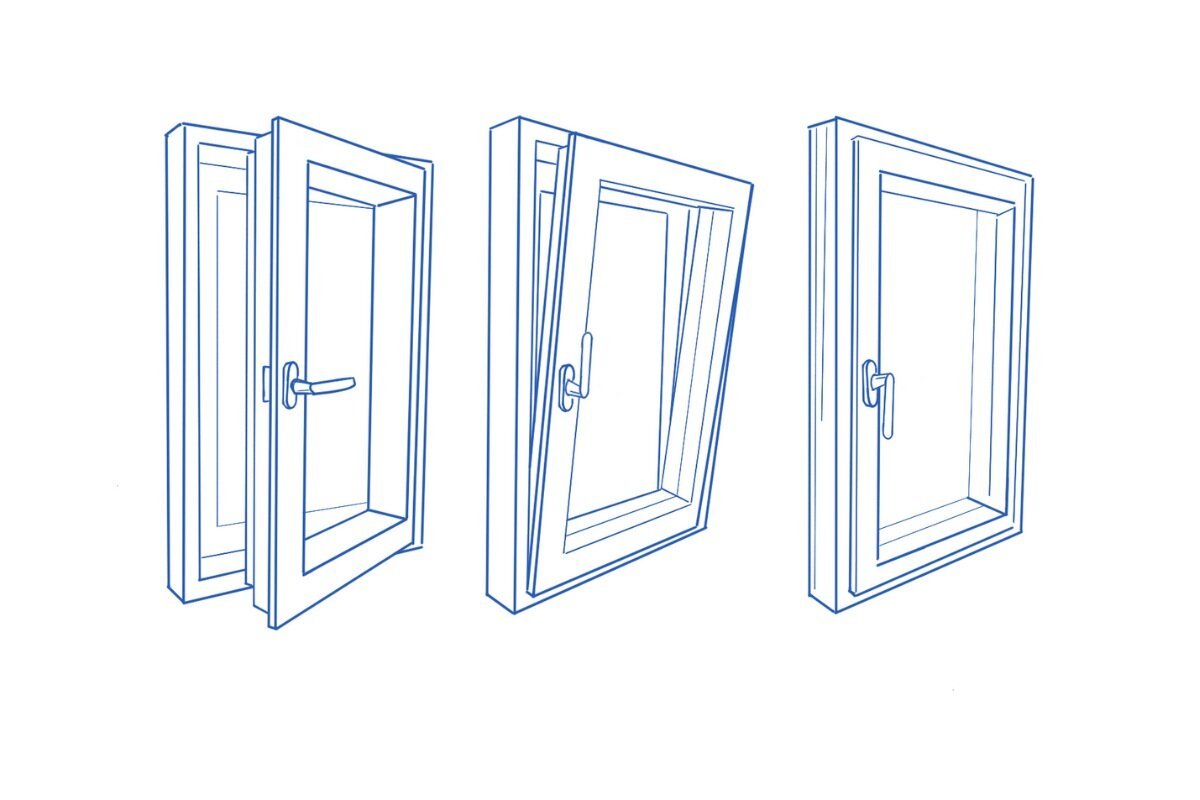European Window Guide Part 1: German Tilt and Turn Windows
If you’ve traveled to Germany, Austria, or Switzerland, you’ve seen a so-called “tilt and turn window”. If you’re lucky, you’ve used one!
Tilt and turn windows are considered the de facto window option in much of Europe. Why? Tilt-and-turn windows promise unique functionality and design, enhanced security, better quality, superior thermal efficiency and exceptional durability and longevity. That said, the tilt and turn functionality is only one aspect of European window design. In this blog post, we will explain what’s special about tilt and turn windows to help you decide if they are the right fit for your project.
Tilt and turn windows can turn open like a door and tilt for secure ventilation.
What is the history of tilt and turn windows?
Tilt and turn windows are the standard in Europe, enjoying a position of near exclusivity in the European window and door market. But even with such a significant level of adoption across the continent, they are still a fairly recent invention.
The first tilt and turn hardware for windows was designed in Germany in the 1950s. Manufacturers gradually moved from using two single-glazed windows, installed one in front of the other and opening separately, to one window with double glazing to keep the cold at bay. With that, the ease and flexibility of opening the single window became more important, making the tilt and turn hardware a life-changing invention.
This trend coincided with the first vinyl window, designed in Germany in 1954 and installed in a home in Hamburg. While initially expensive, the use of vinyl ultimately enabled German manufacturers to produce windows with incredible thermal properties at very low cost. Suddenly, there was a low cost-option to deal with the cold German climate in the winter, while allowing easy ventilation and opening in the mild summer, making climate control obsolete. From then on, thermally efficient tilt and turn windows increased their market share quickly, triggering frequent innovations and making a wide selection of materials available, including vinyl, wood, aluminium and steel. The European window market was never looked back.
How do tilt and turn windows work?
Tilt and turn windows work by the simple turning of a single handle. There are three different positions for the handle, each of which allows unique functionality.
When the handle is pointing downward and the window is closed, at least five steel locking pins keep the window securely shut.
When the handle is turned by 90 degrees into the horizontal position, the window functions a lot like a normal door. In this position, the locking pins are unlocked and the window vent turns open, held by hinges on one side of the window. There is one hinge on the upper corner and one on the lower corner, just like you would see it on a regular door.
Only when the handle is turned by another 90 degrees, pointing upwards now, the window starts operating differently than a door. The hinge in the upper corner is disconnected. At the same time, a hinge in the other bottom corner of the vent is connected to the vent. The vent suddenly tilts inwards, held by the hinges the bottom corners. That is possible because of an ingenious design: One of the hinges on the lower corner operates in two directions, supporting both tilt and turn. The other two hinges support only tilt or turn but are only connected to the vent if the window handle is in a certain position.
With that, the whole window can open like a door or just tilt inward by 10 to 15 degrees, moving along the hinges on the bottom of the window and allowing easy ventilation without having to worry about intruders or weather changes.
What does it mean for your project?
The unique functionality of tilt and turn windows allows builders and architects to open residential and commercial spaces to the environment in very different ways.
The most common style of window in the US is a double-hung window. A tilt and turn window offers dramatic improvements over a traditional double-hung window, including:
Tilted European window
Unobstructed views and seamless integration.
Enhanced ventilation.
Advanced thermal efficiency.
Serious security.
While the opening of a double hung windows is always less than 50% of its size, tilt and turn windows open all the way, leaving only the frame. With one uninterrupted glazing pane instead of two on a double hung window (fixed element and vent), they provide a completely unobstructed view of the outside, even when closed.
Also, the tilt functionality allows you to include ventilation through windows into your climate control concept without having to face the adverse effects of an open double hung window.
If you’re interested in environmentally conscious building design, tilt and turn windows provide exceptional thermal efficiency and can be customized to meet even the most strenuous passive house or other environmental standards.
Finally, a tilt and turn window is nearly impossible to break into, but we will talk more about that later..
Are there any potential pitfalls?
When making use of these new design options, be sure that you consider one more thing that comes along with the tilt and turn design: All tilt and turn windows open inwards.
That has various reasons. Due to mechanical requirements, the handle that operates the window hardware is installed on the window vent, opposite of the hinges. Thus, it tilts and turns with the window. Think of a large, outward turning window on the third floor and you understand quickly why tilt and turn windows are designed to open inwards. Also, with opening inwards, the hinges can be placed on the inside of the window frame, protecting them from weather and potential corrosion. Last but not least, with tilting inwards, wind gusts can’t push the tilted window shut.
Thus, as you’re utilizing the design options provided by tilt and turn windows, plan for sufficient room for the windows to open inwards.
What else is special about tilt and turn windows?
As already briefly mentioned, all tilt and turn windows have at least five metal locking pins installed along the inside of the vent. When the handle is moved into the ‘closed’ position (pointing down), these pins are sliding into metal rails on the frame, pulling the vent tightly shut. This has multiple advantages: By sliding the pins into the rails, the vent connects with the frame in the optimal position, assuring maximum performance and longevity of the seals. With that, leaking almost never occurs on tilt and turn windows.
At the same time, the five point metal locking mechanism, protected between vent and frame, provides outstanding forced entry resistance, outperforming any standard double hung window.
Finally, the metal construction of the window hardware, its positioning between vent and frame and its low wear operation through a single lever assures an exceptional durability of the window mechanism.
Want to know if you can use tilt and turn windows in your project? Contact Bauwerk for more information!
About Bauwerk Building Solutions
Bauwerk is a multinational business that connects US clients to an extensive network of European manufacturers of windows, doors, curtain wall systems, and more. We specialize in innovative and refined building products of the highest quality. Our offices are located in Charlotte, NC and Berlin, Germany.


